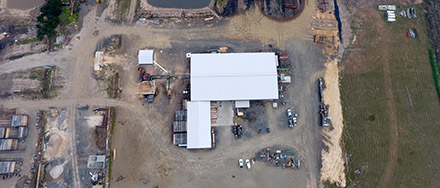Several Gippsland hardwood timber processors have vowed to continue operating despite being barred from access to the region’s native forest. Source: Philip Hopkins LaTrobe Valley Express
The chief executive of the Victorian Forest Products Association, Deb Kerr, said the start of 2024 marked the end of harvesting wood fibre from Victoria’s public forests, but not the end of Victoria’s sustainable native hardwood industry.
“The Victorian government’s decision last May created chaos with some businesses across the native hardwood supply chain being forced to either close permanently or diversify their business,” she said.
“However, a small number of processors will continue processing the native timbers that consumers love, sourcing this wood from private sources in Victoria, from other states and from overseas. Hardwood timbers are highly valued by consumers where appearance or durability are important purchase considerations, be it stairs, decks, windows, furniture, or external applications.”
In Gippsland, Australian Sustainable Hardwoods (ASH) at Heyfield began importing hardwood timber from the US some time ago as the state government began restricting hardwood supplies from Gippsland forests. ASH, which employs more than 200 people, is going to import more US hardwoods to make up some of the shortfall.
Radial Timber in Yarram will go into ‘survival mode’, sourcing what local plantation timber it can get until its own plantations grow. The company, which has been growing its own plantation estate for 18 years, had been relying on timber from VicForests for another six years. The Radial mill will run at 25% capacity in the intervening six-year period.
The white paper line at Opal’s Maryvale Mill in the Latrobe Valley, which relied on native hardwood residues and woodchips, ceased production last year, throwing 150-200 people out of work, but the company will still require timber for its packaging production.
Ms Kerr said she did not have full confirmation of how many mills had closed, but 11 mills in Victoria took compensation payments from the first round of exists before the May 2023 announcement that timber harvesting in native forests would close at the end of 2023.
“Some of those closing have drying stocks of timber that will last between one-to-three years. The full effects won’t be realised until probably 2026,” she said.
Ms Kerr said while the government had closed native forestry, Victoria’s forests still needed to be managed for the health and resilience of the forest.
“The continued decline of Victoria’s native plants and animals is commensurate with the in-crease in the National Park estate – clearly this speaks volumes that the current management approaches do not work,” she said.
“The Victorian government should use the start of this new era to radically change the way Victoria’s forests are managed for the next century – after all native forestry can no longer be blamed for the state of Victoria’s forest flora and fauna.”
Ms Kerr said a recent CSIRO report showed that feral animals and invasive species were by far the biggest threat to forest fauna and flora.
The report, conducted with the Centre for Invasive Species Solutions, found that at least 100 unique native species had become extinct since European settlement, with three quarters due wholly or partly to invasive species. These included mammals, frogs, birds, and lizards.
“Dozens more species are at high risk of extinction in the next 20 years, including mammals, birds and reptiles threatened by cats and foxes … and plants by pathogens and feral herbivores,” the report said.
From 1960 to 2017, invasive species cost Australia at least $390 billion, with the current annual cost conservatively estimated to be about $25 billion.
“It has increased up to six-fold every decade. Weeds cost agriculture at least $5 billion a year,” the report said.






